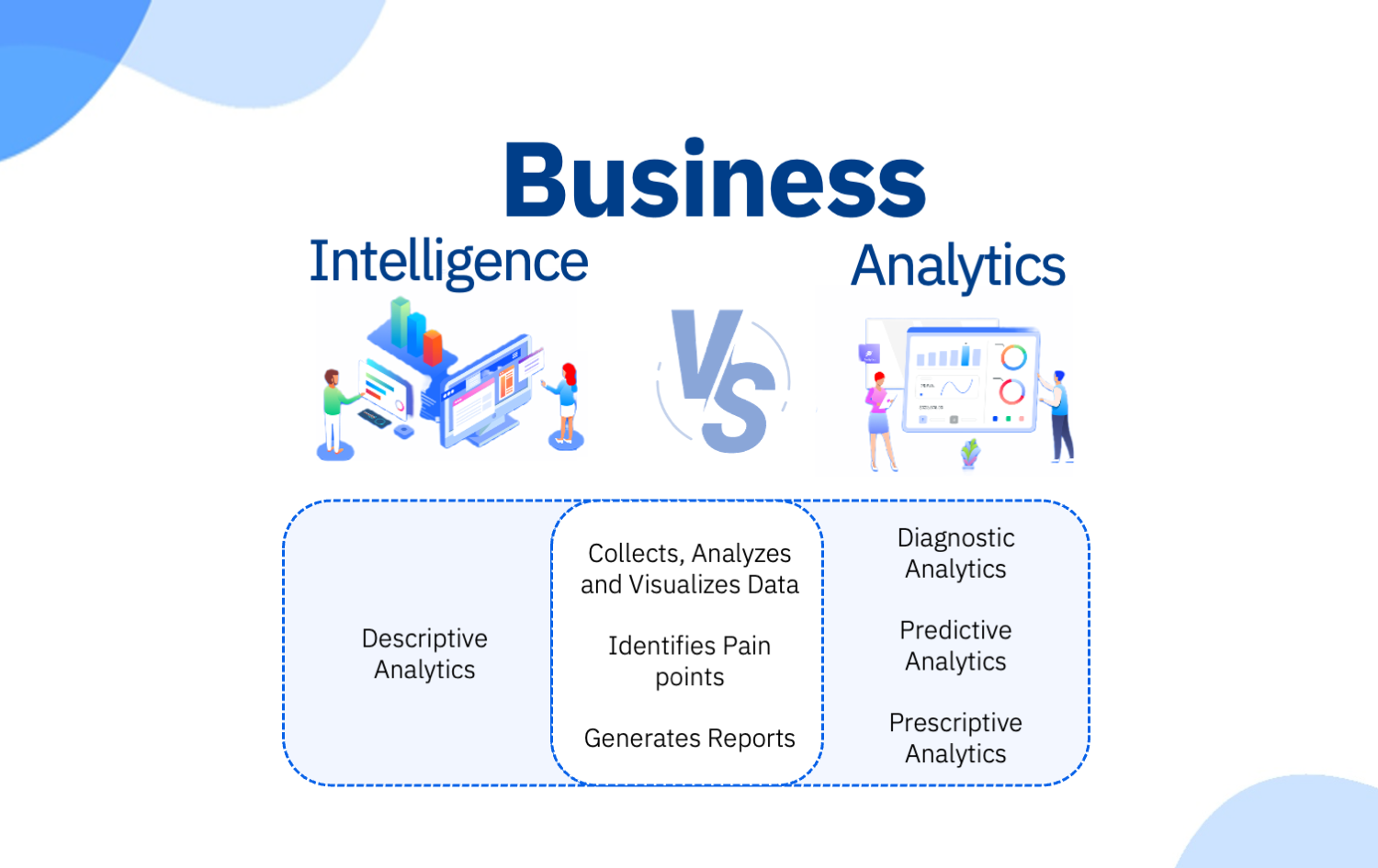Business Intelligence and Analytics: How Are They Different From Each Other?

Professionals commonly use the phrases “Business Intelligence” and “Analytics” interchangeably. Is it the same with you? Then, let’s have a look at why it’s not so.
There is some crossover between the definitions of Business Intelligence and Analytics, which is why industry insiders regularly argue about the distinction. However, in order to help firms, executives need to know the difference between Business Intelligence and Analytics.
What is Business Intelligence?
According to traditional definitions, the purpose of Business Intelligence (BI) is to help companies better manage their daily operations via the analysis of data. In order to gather and store data regarding ongoing operations, optimise workflow, provide useful reports, and fulfil their current company objectives, leaders utilise Business Intelligence tools and specialists.
It is possible to use a wide range of development tools and other platforms as Business Intelligence tools. Among them are spreadsheets, advanced analytics, reporting software, company performance monitoring tools, and information retrieval software. Predictive and empirical technologies employed in Business Analytics might also be considered part of Business Intelligence, according to experts.
As a whole, Business Intelligence helps executives manage organisational and industry-related problems and guarantees that organisations keep focused on their key aim Key Performance Indicators (KPI’s) to effectively achieve their goals.
What is Business Analytics?
The area of Business Analytics has traditionally been regarded as a statistically based one, where data professionals employ quantitative tools to create forecasts and design future development strategies. Analytical data may tell company executives what their future consumers will look like, while information from Business Intelligence can show them the characteristics of their existing clients. Some professionals use the term “Business Analytics” to define a collection of prediction techniques employed in the area of Business Intelligence.
Reliability tests, linear regressions, projection analysis, text analytics, and visual analyses are just a few of the numerous business analytics applications. Many of these technologies need the hiring or contracting of Data Scientists, which has led to a rise in the demand for Business Analytics expertise.
Business Intelligence vs. Business Analytics
Business Intelligence and Analytics are quite different concepts. These variations are a reflection of changes in business jargon and employment development, as well as the average size of a corporation and its inclination to invest in the present or future. Investing in Business Intelligence and Data Analytics tools for a company requires executives to take these variances into account.
1. Current Scenario
Even though they have a lot to do with each other in their meanings and usages, Business Intelligence and Analyics seem to be two distinct terms. More individuals have searched for Business Analytics on Google than for Business Intelligence, indicating the phrase’s expansion as an overarching concept rather than a specific definition of quantitative and prognostic tools.
This increase in analytics references might be attributed to the field’s expansion. The sector is now experiencing a talent shortage, as businesses fight for a limited number of data analysts, data scientists, and analytics executives.
2. Organization’s Maturity
A company’s size might also influence the use of Business Intelligence and Analytics solutions. As a result of the lack of data science expertise in smaller businesses, business intelligence technologies may be utilised by these organisations to enhance their operations or prepare for the future. Even the smallest of businesses are looking for solutions that can assist in both present operations and future forecasting.
Management decisions about using intelligence and analytics technologies are also affected by the age of a business. Business Analytics could be most helpful if a company is just getting started or has just experienced a major shift. If you have access to a huge quantity of data and are looking to compete with the big, more established organisations, these tools may be of interest to you.
Some well-established firms may want to use Business Intelligence solutions to understand more about their processes or personnel performance. As a rule of thumb, the majority of enterprises will seek some mix of both.
3. Current vs. Prospective Focus
The emphasis on the current or future difficulties of a company is a popular way to differentiate between Business Intelligence and Analytics. Some experts contend that Business Intelligence uses past data to make current-day choices, while Business Analysis uses previous data to forecast future events or how an organisation might progress.
Leaders who are comfortable with corporate operations but wish to improve efficiency, simplify procedures, or fulfil a particular objective may benefit from a current focus utilising business intelligence. Insights from business analytics may be more beneficial to individuals seeking to alter their company model or main organisational functions.
Conclusion
The discussion over defining business intelligence and analytics will continue as patterns and terminology develop. However, it’s reasonable to assume that most companies will make investments in both their present operations and their long-term performance, resulting in a need for both tools and professionals.
